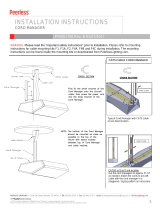
Planning
900-0197-01-00 Rev B 11
E. Conductor efficiency: Wire size and other factors will
waste power due to resistance and voltage drop.
Typical acceptable efficiency is 96 to 99%.
F. Inverter efficiency: FX specifications list “Typical
Efficiency” to help estimate operating loss.
G. System DC voltage: Each inverter model requires a specific DC voltage to operate.
H. Battery voltage: Most individual battery voltages are less than the system DC voltage. The batteries may need
to be placed in series to deliver the correct voltage.
I. Capacity: Battery capacity, which is measured in
amp-hours, is not usually a fixed number. It is
specified based on the rate of discharge. For
example, the OutBack EnergyCell 200RE is rated
at 134.5 Ahr when discharged at the 5-hour rate
(to terminal voltage 1.85 Vpc). This is a high rate
of discharge that would hypothetically drain the
battery in 5 hours. The same battery is rated at
191 Ahr when used at the 100-hour rate. Use the
appropriate discharge rate (correlated to the
expected loads) to measure the capacity of a
battery. Use battery specifications for terminal
voltage 1.85 Vpc whenever possible.
NOTE: Capacity ratings are for batteries at 25°C.
Capacity is reduced at cooler temperatures.
J. Maximum depth of discharge (DoD): Most batteries cannot be discharged below a certain level without
damage. The bank requires enough total capacity to keep this from happening.
To Calculate Minimum Battery Bank Size (refer to Table 2 for letter designations):
1. The load size, item A, is measured in watts. Compensate this figure for efficiency loss. Multiply
the con
ductor efficiency by the inverter efficiency [E × F]. (These items are represented as
percentages, but may be displayed as decimals for calculation.) Divide item A by the result.
2. Convert the compensated load into amperes (Adc). Divide the step 1 result by the system voltage
(item G).
3. Determine the daily load consumption in ampere-hours (amp-hours, or Ahr). Multiply the step 2
result by the daily usage hours (item B).
4. Adjust the total for required days of autonomy (the days the system must operate without
recha
rging) and the maximum DoD. Multiply the step 3 result by C and divide by
J.
The result is the total amp-hour capacity required for the battery bank.
5. Determine the number of parallel battery strings required. Divide the Ahr figure from step 4 by the
indivi
dual battery capacity (I). Round the result to the next highest whole number
.
6. Determine the total number of batteries required. Divide the system voltage by the battery voltage
[G ÷ H]. Multiply
the result by the step 5
result.
The result is the total required quantity of the chosen battery model.
EXAMPLE #1
Any losses are essentially amp-hour
capacity that the system cannot use.
The battery bank size can be increased
to account for losses.
1) A ÷ [E × F] 500 ÷ [0.98 x 0.9] = 566.9 W
2) 1 ÷ G 566.9 ÷ 12 = 47.2 Adc
3) 2 × B 47.2 × 6 = 283.4 Ahr
4) [3 × C] ÷ J [283.4 × 1] ÷ 0.8 = 354.3 Ahr
5) 4 ÷ I 354.3 ÷ 148.8 = 2.38 (rounded to 3)
6) [G ÷ H] × 5 [12 ÷ 12] × 3 strings = 3 batteries
A. Loads: 0.5 kW (500 W)
B. Hours of use: 6
C. Days of autonomy: 1
D. Trailer system (FX2012MT inverter)
E. Conductor efficiency: 98% (0.98)
F. Inverter efficiency: 90% (0.9)
G. System voltage: 12 Vdc
H. Batteries: OutBack EnergyCell 200RE (12 Vdc)
I. Capacity at 8-hour rate: 148.8 Ahr
J. Maximum DoD: 80% (0.8)
Table 2 Battery Bank Elements
Item Source of information
A. Load Size Site-specific
B. Daily Hours Site-specific
C. Days of Autonomy Site-specific
D. Application Site-specific
E. Conductor Efficiency Site-specific
F. Inverter Efficiency Inverter manufacturer
G. System Vdc Inverter manufacturer
H. Battery Vdc Battery manufacturer
I. Capacity Battery manufacturer
J. Maximum DoD Battery manufacturer























